Instead of screaming into the void of Twitter, I bring you a weekly highlight reel of what it’s like going places in Greater Hartford when one is gloriously car-free. These posts are on a slight time delay because nobody needs to know exactly where I am when I am there.
SIMMERING ABOUT SIMSBURY
Getting to and from Simsbury, during the white-collar workday on a weekday, is easy. I wrote about that here.
But I held back on something: Simsbury has a silver Bicycle Friendly Community ranking, and I am trying to decide if these awards have any meaning.
Short answer: no.
Simsbury has bike racks and a bike path. It’s a lovely path. It goes near restaurants.
However.
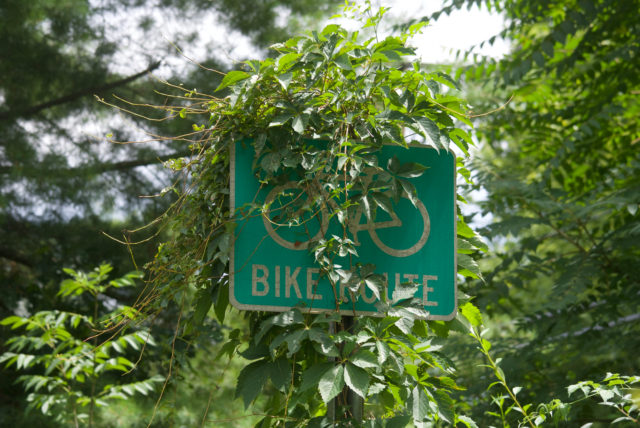
The town is slacking on maintaining its vegetation, whether that means keeping walking paths clear of poison ivy or keeping signs clear so people can read them.
At the same time, there were signs everywhere. They’re leaning hard on signs to do the work that could be done quietly with barriers.
Anyone want to guess how many things are wrong with the picture below?
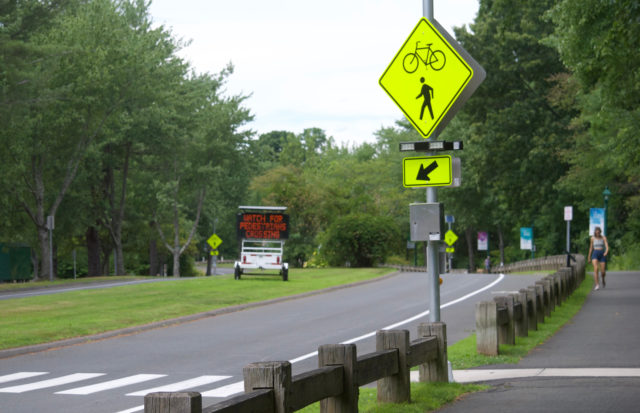
Why are this many signs needed?
Visual clutter.
Do you want drivers reading signs or scanning for people and critters who may be trying to cross?
Why do people need to press a button to get a flashing beacon?
There’s an unprotected bike lane in the road, and I’m going to go big and suggest that for the price of some bollards, Simsbury could eliminate almost every sign around as the road would become narrower and drivers would go more slowly.
It’s not that I’m anti-sign.
There’s a time and a place.
Those flashing beacons or those day-glo signs could make a difference somewhere. The first place that comes to mind is in West Hartford where the Trout Brook Trail crosses awful intersections. That trail is not as visually obvious as the Farmington Canal Trail. Even then, my feeling is that the signs are there until the more appropriate response — redesigning disaster intersections — can happen. And these things can happen faster than we have grown accustomed to: it takes political will, it takes decent engineers, it takes municipalities willing to apply for grants.
Back to Simsbury: it’s not the overabundance of signs itself that’s the issue.
It’s this:
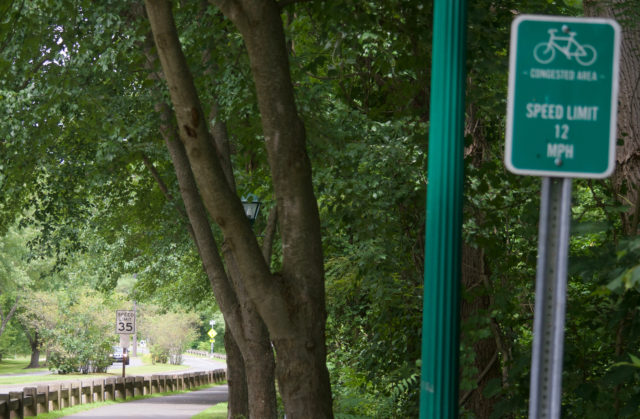
Explain this to me like I’m Jorts: why is the speed limit for cyclists 12 MPH, while drivers can go triple that with heavier vehicles that do more harm in collisions?
35 MPH in an area with a lot of foot traffic. 35 MPH next to an unprotected bike lane. 35 MPH by a park, a dog park, a popular outdoor performance space.
Are you kidding me?!
Riverside Road and Drake Hill Road, also areas where there’s foot traffic, have slower posted speed limits, but I can’t say I saw anyone driving close to 25. It’s not that Simsbury doesn’t know these are issues. You don’t paint the speed limit on Riverside Road, in addition to posting signs, if people are doing what is safe. Neither that nor the threats of radar checks seems to make a difference.
Simsbury has the money, and if its flower bridge is any indication, it has people with creativity.
If given the choice between an unlimited supply of signs or two dozen oversized flower planters, I’m going with the latter and placing them around the town center as ways to entice drivers to slow down.
This isn’t picking on Simsbury. This is me asking why, collectively, our standards are so low. Other Connecticut towns have these rankings and the only one I think has come close to earning it is New Haven, but that’s because I’m applying my criteria, and even then, we just had a car able to be launched on top of other cars.
Anyway, while I was waiting to cross Hopmeadow Road, gazing at the marked crosswalk with its marking worn nearly away, this is what I was wondering about. You can put your bike on the bus (M-F, outmoded business hours only) and be delivered to the bike path, but if you exit the path, are you really in a bicycle friendly space?
SMALL STATE, SMALL THINKING
After wrong-way crashes on Connecticut’s interstates claimed the lives of 20 drivers and passengers within the first seven months of 2022, it was announced that flashing signs costing some absurd amount would be installed to let people know they were going the wrong way.
It’s a half-assed effort, but an effort nonetheless.
Motorists should be on the phone with the powers that be, demanding something more substantial be done. I made a few suggestions back in February, but in one sentence, what I would like to see: ignition interlocks on all motor vehicles, geofencing on motor vehicles, speed limiters on motor vehicles, and those parking lot gates installed across, say, the top 20 problem exit ramps with the gate closed during the hours when these wrong way crashes are most prevalent.
I like solutions that address more than one specific problem.
Putting ignition interlocks on all vehicles, regardless of the driver’s history, is one. It reduces the wrong way crash problem. It addresses other impaired driving issues. Currently, an interlock device can be required after someone has been convicted of driving while intoxicated/impaired. This feels backwards. It feels like punishment instead of prevention.
Who remembers last year when the “tough on crime” crowd was freaking out about stolen cars, but only to beef up police forces and increase ways thieves could be punished? I will kink shame when it comes to people who get off on “law and order.”
Requiring ignition locks on all vehicles means that when those unlocked cars in the suburbs get broken into, there’s another level of property protection. This is the other benefit of using geofencing and speed governors — when stolen, the thief can only go so fast and only in certain areas. It’s not foolproof, but how is this not better than our “people need to make better choices” failed model?
Last week, I saw an orange sports car being driven down Park Street at highway speeds. I am not exaggerating. This morning, I saw news that a vehicle of the same general description was clocked at 161 MPH in New Hampshire. Driver from Connecticut. Maybe it was the same person, maybe not. There is no reason for any vehicle to be allowed to reach that speed. How are we not using technology to ensure that only NASCAR drivers, while on the actual track, are able to go that fast?
You know what thwarted leadfoot?
It wasn’t cops able to go super fast.
It was getting stuck in traffic.
Anyway, I don’t know how people who drive regularly are staying so quiet over such a tiny step when it comes to wrong-way crashes, especially when the Office of Legislative Research prepared material — in 2008 — about how other states attempt to prevent wrong way crashes.
In this same period — January through July 2022 — 40 pedestrians and cyclists were killed in Connecticut. There’s no urgency.
This is a faceslap when last week, after one electric bus caught fire and nobody died, CTtransit pulled the whole e-bus fleet.
They were right to hit pause while investigating.
Why do we not get the same courtesy when a driver runs down a person crossing the street? Close down the road and suspend that motorist’s license until the cause is determined and addressed in a real way.
Why do we hesitate to demand more? Why are people’s lives so cheap?
I think we can ask for more.
HIGHWAY BLINDSPOT
Have you tried walking over the Sigourney Street bridge since construction moved to the west side?
I have. . . and it’s a different experience when you’re walking north versus south.
I don’t know if anyone who designed this will be walking the bridge regularly, (ha ha, just kidding, I know — they won’t) but there’s a flaw. Maybe they can fix it before they pack up all their giant machines, but I’m guessing they’ve decided that their work on the east side is done.
When you’re walking north, on the east side of the bridge where the redundant ramps are (there are 84 ramps just a few blocks away on Capitol Avenue and Broad Street) you can see the oncoming traffic that’s about to turn onto the highway. Of course, once the road completely reopens, you’d have to be looking out for the people turning right on red. Then, as you cross the exit ramp, you have an okay view and can confirm (inasmuch as you can ever confirm) that the driver is stopping at the light.
When walking south, you are officially Shit Outta Luck.
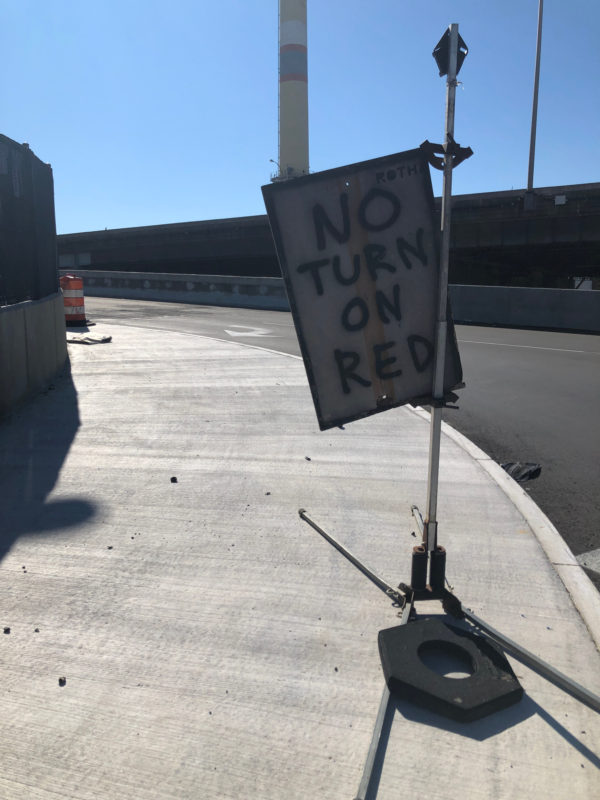
You don’t have a decent view of cars on the exit ramp until you are halfway across it and the right turn lane is designed to allow people to make that turn without coming to a full stop first.
What?! Who thought this was a good idea?
Then, when you go to cross the entrance ramp, it would seem easier because there aren’t vehicles coming from more than one direction except that it’s another blindspot and very few drivers are obeying the red light.
There are functioning pedestrian lights at both ramps.
There are dysfunctional drivers, turning left on the red light.
It’s not registering with them that the light is red for a reason.
Why is it, again, that we don’t have automated enforcement?
This is a construction zone.
It is one block away from an elementary school, a park, a residential neighborhood.
Just kidding. I know why we don’t have this.
MAINTAINING PEDESTRIAN ACCESS
A bus driver recently told me about his frustration with the forever construction project on Pearl Street. It’s the one where they closed the sidewalk but made no temporary walk. The result is predictable: people walking in the street. He expressed nervousness about hitting someone who is in his blindspot.
Some of us having been asking the mayor or putting it in 311 when we see these issues — not that it seems to do much good. Pearl Street. Capitol Avenue by The Bushnell. Park Street by Main Street. Those are a few places with long term problems — sidewalks closed without an alternate parallel route created for pedestrians.
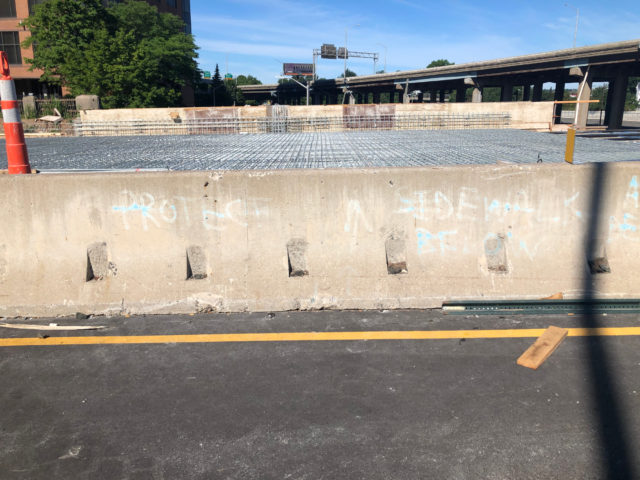
This pic was taken of one of the jersey barriers on the Sigourney Street bridge. The message is hard to read, but it says “PROTECT SIDEWALK BELOW.”
Why?
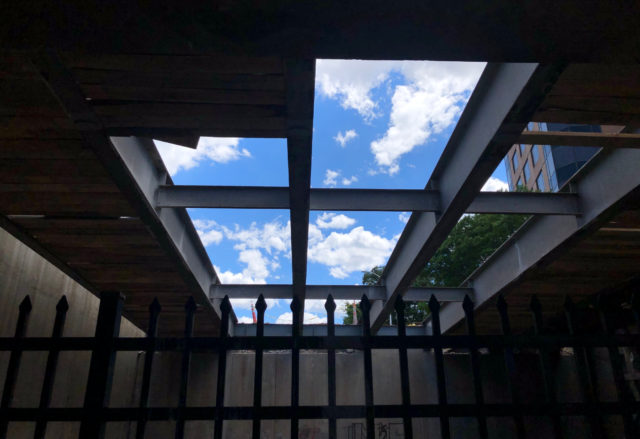
They’ve been removing the bridge decking and the sidewalk below has not been adequately protected.
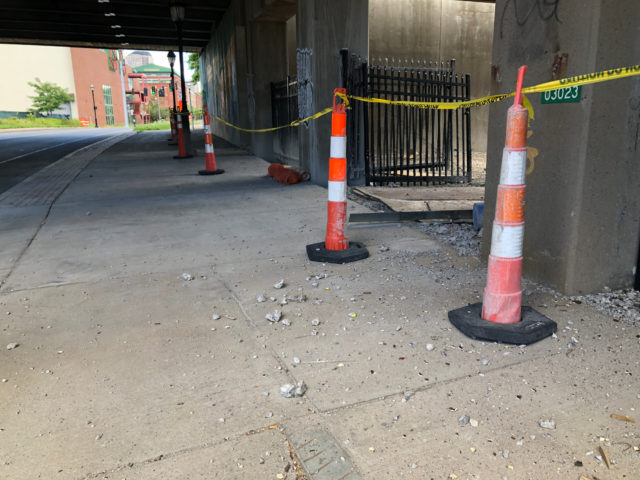
Those are bits of concrete right out on the sidewalk.
In addition to swaddling myself in hi-vis am I supposed to wear a hard hat now?
In other places, the disregard is shorter term.
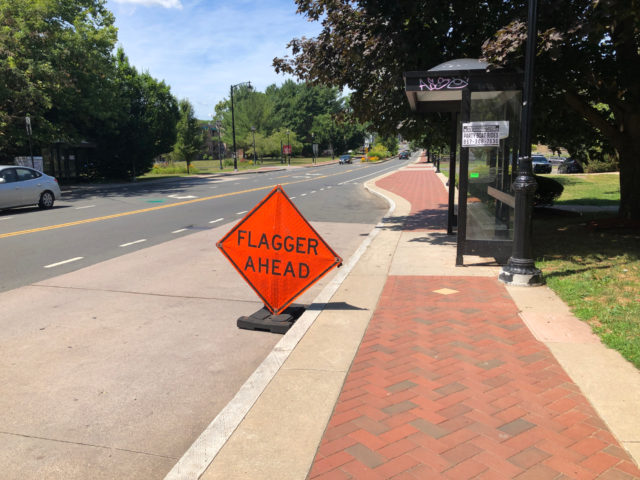
That’s a construction sign dropped carelessly into the bus stop.
(Spoiler: there was no flagger ahead!)
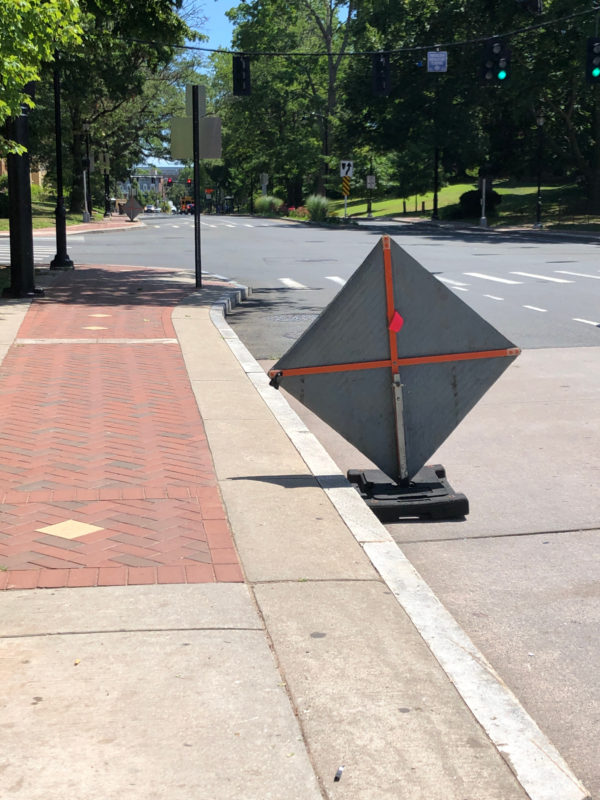
I turned around to see that on the previous block, that sign was dropped on the sidewalk. A few seconds after I snapped this phone pic, someone wheeled through in a chair and needed to go up on the lawn because the sign blocked half the sidewalk.
It’s the pattern of it that’s irritating. How might we deliver messages in a way that doesn’t impede pedestrians, bus drivers, those boarding buses? How could we plan construction projects so that people outside of vehicles are (1) kept safe, and (2) not ridiculously inconvenienced?
What comes to mind is that cheesy graphic that gets trotted out explaining the difference between equality and equity. From an equality standpoint, detouring pedestrians the same distance as vehicles seems correct. From an equity standpoint, we look at the time and effort involved, and can see that a five minute vehicle detour and a 15-minute pedestrian detour are not the same. Want to challenge that? Meet me on the corner of Sigourney and Farmington when it’s 95ºF and we’ll take a walk.
ELMWOODN’T IT BE NICE TO HAVE ACCESSIBLE SPACES?
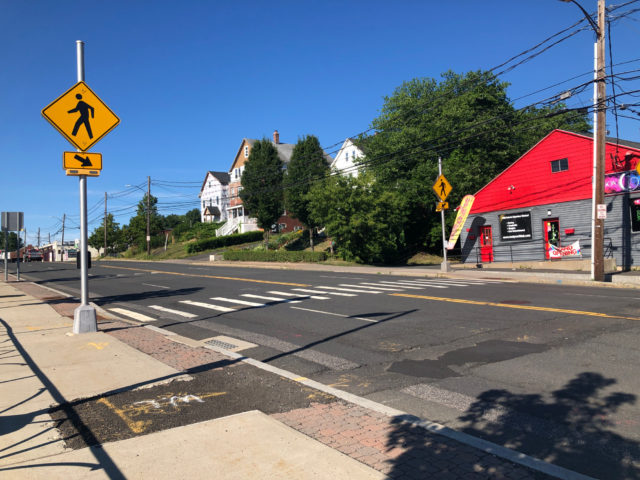
This is one of those occasions where someone decided to toss in a couple of blinking sign lights instead of doing what needed to be done: eliminating two of those four travel lanes and installing a barrier-protected bike lane. Perhaps if we called it a multi-use trail or bike path the idea would get some traction.
New Park Avenue is a disgrace.
Yeah, yeah, yeah, I know it’s slated for a renovation of some kind, but based on what was trotted out as the North Main Street “road diet,” I’m not expecting to be impressed or even remotely satisfied.
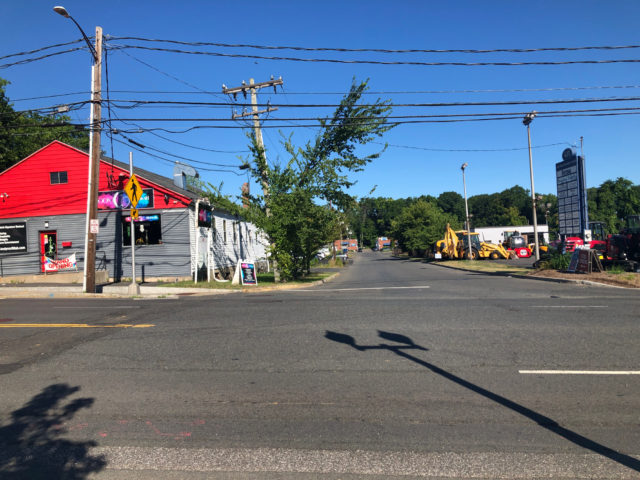
I don’t think West Hartford or the property owners can handle fixing the driveway/road that leads to GastroPark so that people walking from their homes, the Trout Brook Trail, or any of the bus stops nearby aren’t needlessly dodging the parade of SUVs. You don’t have to add concrete. You can place barriers on the road to create space for people to move. Is this a place for people to hang out? Make it feel like that. Lose the gross parking lot vibe.
But I think West Hartford is too addicted to their car culture.
Prove me wrong.
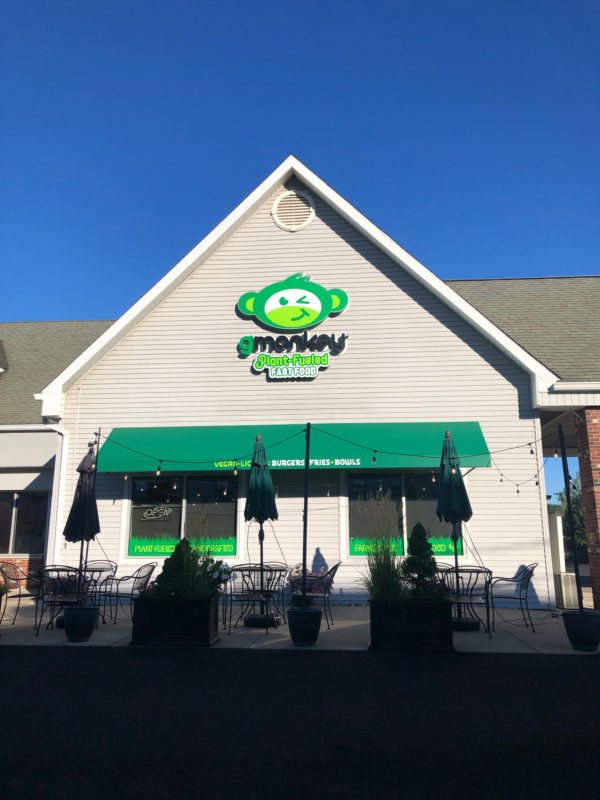
Those working on New Park Avenue should be able to walk to get their lunch without it being a hassle or excessively risky.
Will property owners reconsider how many driveways businesses “need”? Each one represents a point for conflict.
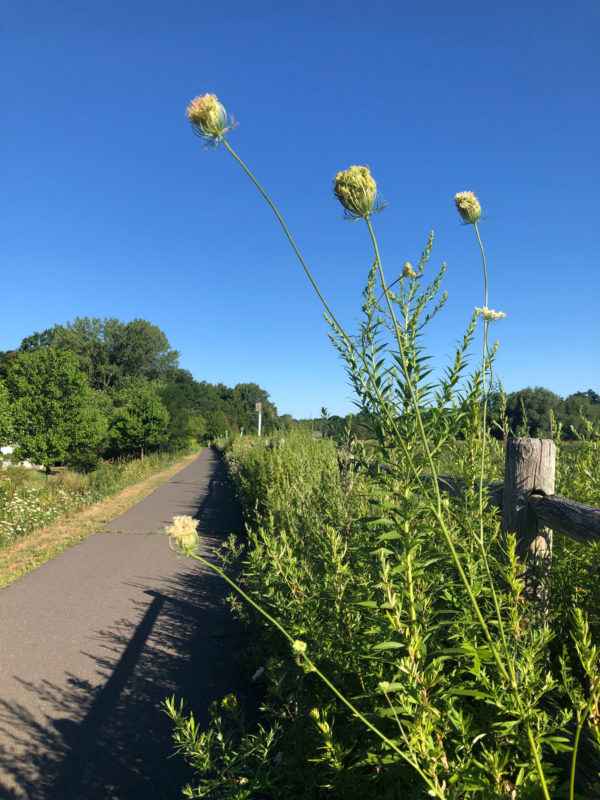
The Trout Brook Trail ends across from the new BiCi Co. bike shop.
New Park Avenue divides the two.
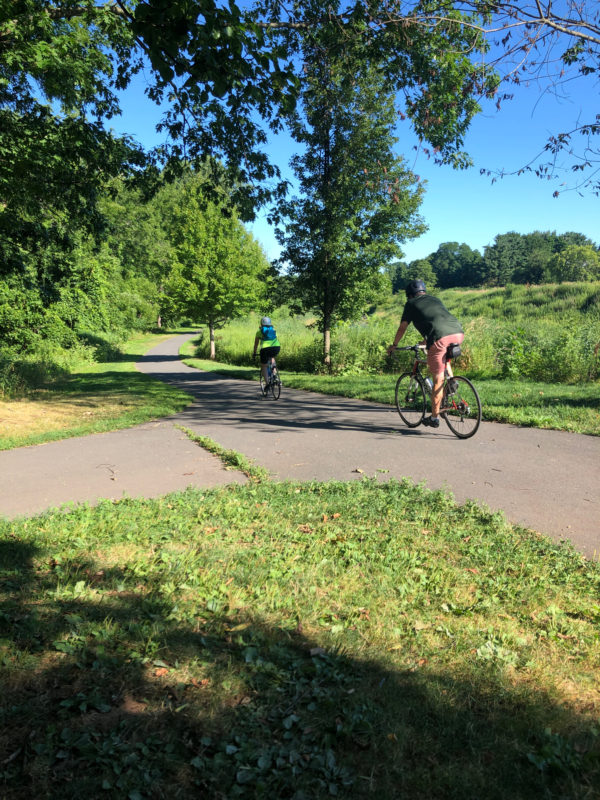
You can have all the nice attractions you want, but if it’s a pain to get to these places, you’re losing out on who will make the trip.
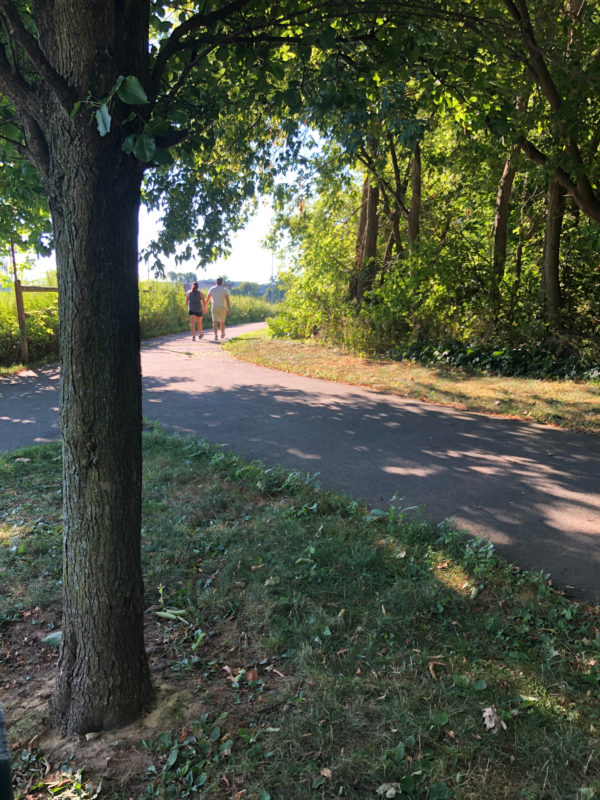
I made a rare visit to Small State Provisions last weekend. It’s really too bad, because I like the bakery, but not enough to have visited more than twice in three months. The bus ride is fast. It’s not far at all from the stop or station, but whichever bus I take, I will have to cross New Park Avenue at some point and either way, I have to scramble down that unnamed road/mega-driveway being stupidly vigilant when I really should only have to be keeping an eye on my boutique scone. If this were not such a pain, I would be here at least every other week. This spot isn’t even on the radar of some of my other bus riding friends because it’s not a walkable area.
There’s my message: towns and businesses that prioritize cars over humans lose out.
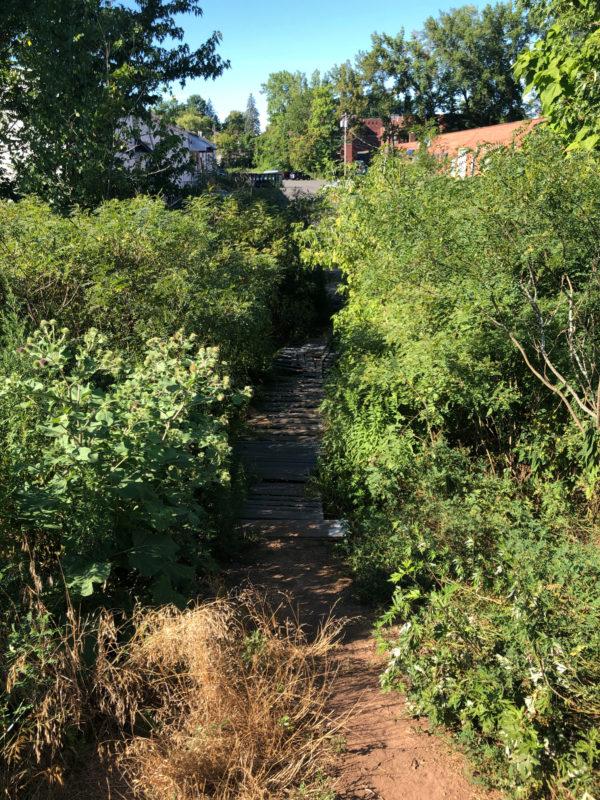
But props to whomever made this DIY path from the main path
TREASURES
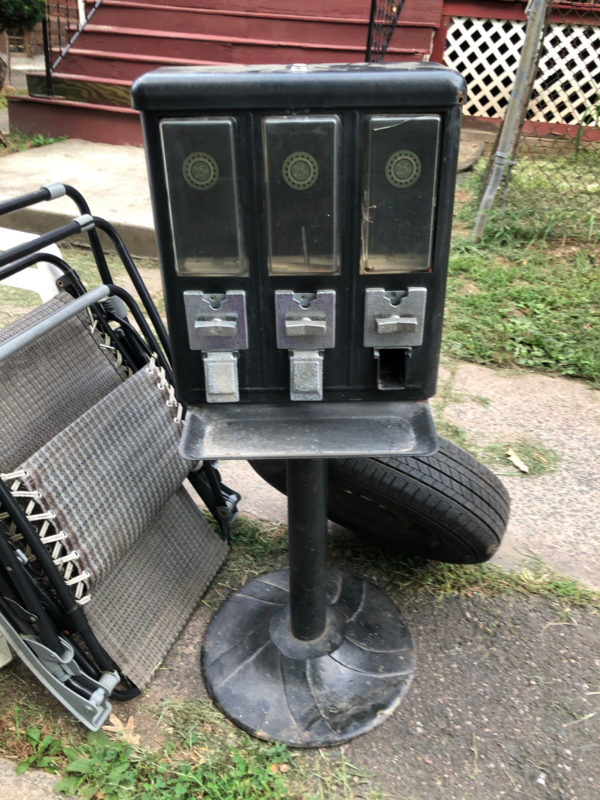
File under: things you notice going slow speeds.
WHAT NEXT
On July 29, 2022 Around 9 PM, a driver struck and killed a currently unidentified man by 318 Silas Deane Highway in Wethersfield. There are five travel lanes. There is no median. He was the 40th pedestrian/cyclist killed in Connecticut in 2022. In 2020, another pedestrian was killed on the Silas Deane where there are six travel lanes and no media.
What can you do about this?
Contact Wethersfield’s officials and tell them “no more.” The Silas Deane, which is not an Interstate, would benefit from removing several travel lanes, adding medians and bumpouts, and other measures to reflect that this area has numerous businesses and residences that people should be able to safely travel to and from. Call for the Town to apply for the State DOT Connectivity Grant to fund proper pedestrian infrastructure:
Michael Rell michael.rell@wethersfieldct.
Town Manager:
Fred Presley fred.presley@wethersfieldct.
Council members:
Tom Mazzarella tom.mazzarella@wethersfieldct.
Ryan Biggs ryan.biggs@wethersfieldct.gov
Ken Lesser ken.lesser@wethersfieldct.gov
Kevin Hill kevin.hill@wethersfieldct.gov
Dan O’ Connor dan.oconnor@wethersfieldct.gov
Pat Pentalow pat.pentalow@wethersfieldct.
Shelley Carbone shelley.carbone@
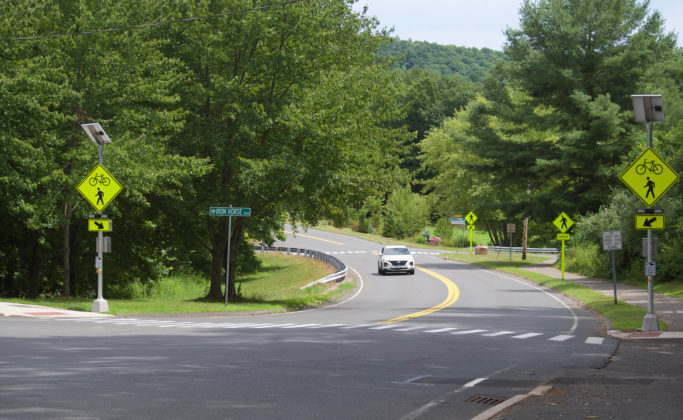
Jim Head
Regarding unsafe pedestrian crossings and specifically Trout Brook Trail, I had the idea that maybe a good start would be to ban right on red for all crossings along Trout Brook Road near the trail… but two things happened this morning.
1) I noticed heading south Trout Brook at Park there’s already a no right on red sign. This is commonly where people right on red, cutting in front of me during the walk cycle.
2) Coming home, crossing Quaker to get to Trout Brook, two cars turned right on red (coming off Trout Brook) during the walk cycle. I dinged my bell at them while waiting halfway across the street. The 3rd car paused at the light so I started to cross, only to have it then turn right and accelerate toward me. They stopped a few feet away, but yes, in the intersection and yes, it was fucking scary.
The more you spend on a bicycle, typically, the lighter that bicycle is. Fuck that. I’m happy my ebike is huge, inefficient, and 100 pounds.
Ban right on red altogether and get less cars on the road.
Kerri Provost
Red should mean stop.
When they allow right on red, it erodes what you’re supposed to do at red lights.
If intersections were designed tight enough, I could be persuaded that right-on-red is okay because people would have to stop or at least slow way down before turning. Since most signalized intersections are not designed well, let’s just go with no right on red anywhere.
Dennis Kane
While I follow your page closely and believe in all the points you are trying to make, I believe Hartford is a lost cause when it comes to anybody giving a shit about cyclists or pedestrians. Cars are too engrained into the culture here, and while this state is democratic, all I see in new sustainable legislation is more EV charging stations and tax credits for buying EV cars, with no word on actual sustainable transportation (E-Bikes, busses, etc.). There was legislation passed months ago giving tax credits to people who purchased E-bikes up to a certain value, but when you are forced to ride on sketchy infrastructure to say the least, people will opt not to use this viable form of transportation. The streets in Hartford are not safe for cyclists, and motorists in general are hostile to cyclists. I have numerous run-ins with motorists telling me to get out of the road, honking, punishment passing, you name it, it’s happened to me, and likely many other cyclists. Life is short, maybe it makes more sense to move to an actual bike-friendly place, and as much as I would love to advocate, it seems like it falls on deaf ears.
Kerri Provost
We have a car-centric culture in the United States.
The people who have more means (which equals more time) have a moral obligation to advocate for safer streets for everybody, so that those working multiple jobs (and don’t have the luxury to decide if they’re swapping any motor vehicle for another because they’re on the bus regardless) have safe, convenient, and dignified mobility options.
Opting out of even trying signifies great privilege.